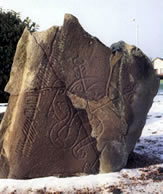Pictish
Facts
- Language: Pictish
- Alternate names:
- Language code: xpi
- Language family: Unclassifiable
- Number of speakers: Extinct
- Script: Ogham
More information:
Introduction

Pictish speaking area (dark blue) in the mid-5th Century AD
The Pictish language was spoken by the Picts, the people of northern and central Scotland in the Early Middle Ages. It was spoken until 10th century.
There is very little direct attestation of Pictish, consisting only of a few very short inscriptions. Also known are a few place names and some names of people found on monuments and the contemporary records in the area controlled by the Kingdom of the Picts.
The Anglo-Saxon monk Bede mentions five languages in his Ecclesiastical History of the English People (completed in 731): Haec in praesenti, iuxta numerum librorum, quibus lex diuina scripta est, quinque gentium linguis, unam eandemque summae ueritatis et uerae sublimitatis scientiam scrutatur, et confitetur, Anglorum uidelicet, Brettonum, Scottorum, Pictorum et Latinorum, quae meditatione scripturarum ceteris omnibus est facta communis.
('At the present time there are in Britain, in harmony with the five books of the divine law, five languages and four nations – English, British, Irish and Picts. Each of these have their own language; but all are united in their study of God’s truth by the fifth – Latin – which has become a common medium through the study of the scriptures.')
Pictish Inscriptions
Most of the surviving Pictish inscriptions use the Ogham script, which was invented in Ireland perhaps around the fourth century and introduced to what is now mainland Scotland via Dal Riada (an Irish-speaking early medieval kingdom in roughly the area of modern Argyll). Ogham is written by making straight strokes across, sloping from or perpendicular to a guideline, originally the edge of a stone.
The verb

Cross slab with Pictish (ogham) inscriptions.
I[-]IRANNURRACTX EVVCXRROCCS
urract 'he/she made'
the text scratched along the length of the small cross-slab from Burrian in Orkney is problematic for several reasons. It is cursively carved with no indication of word division, a number of key letters are damaged and there arc several forfeda characters of uncertain sound-value. A fair transliteration of the ogham letters would be I[-]IRANNURRACTX EVVCXRROCCS. This is rebarbative to say the least, but if we break it up as I[-]irann uract cheuc chrocs we could take the second word as a Pictish cognate of the Old Welsh *guract 'he/she made' (cf. gwreith 'I made') and the fourth as a spirantized form of a straightforward Pictish *crocs, 'cross' (< Latin crux). The third word remains problematic, but if the damaged first word is a personal name we may have here a Pictish sentence explaining who carved the cross.1311

Brandsbutt Stone
IRATADDOARENS
ira 'he lies'
c.f. the Breton irha 'he lies'
External References
Verblist
- ᚒᚏᚏᚐᚉᚈ